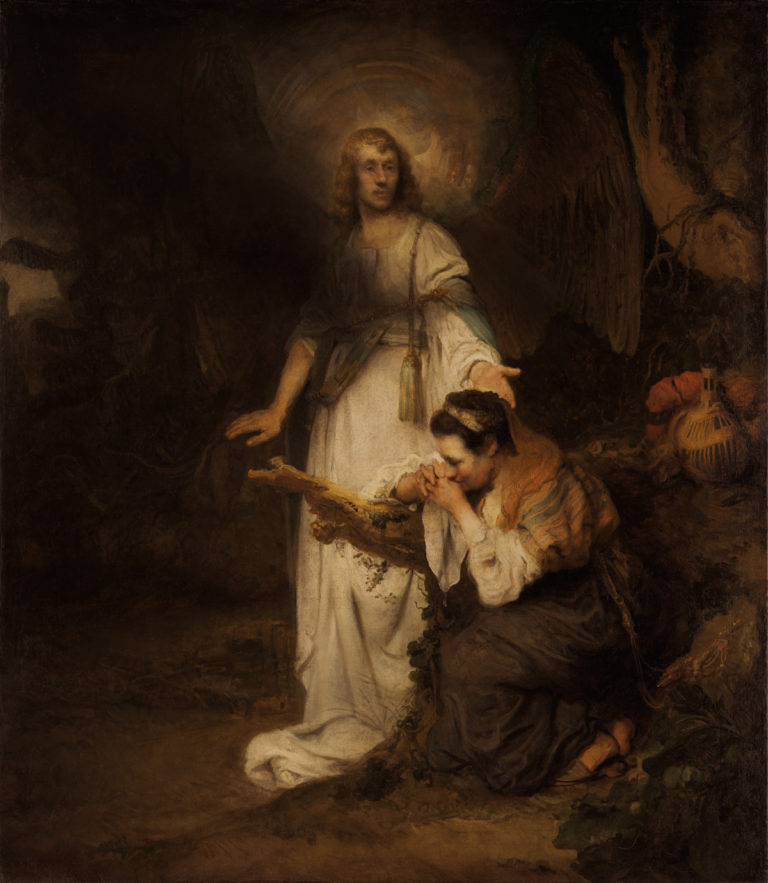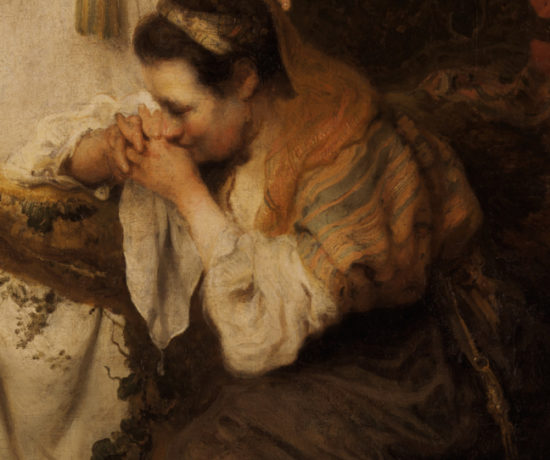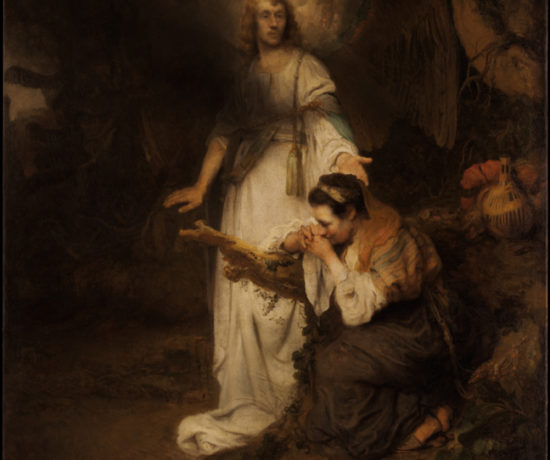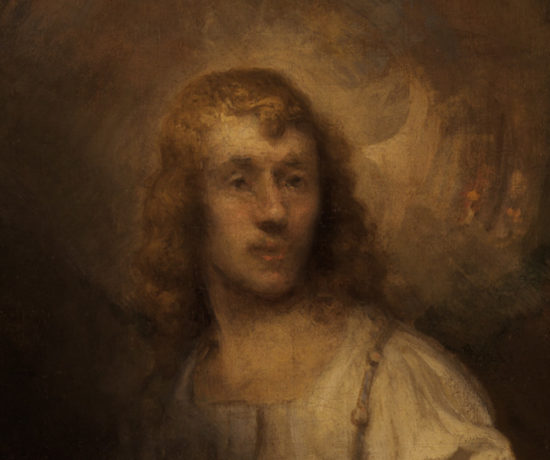Carel Fabritius, who died tragically at the height of his career in the explosion of the Delft powder house in 1654, painted this masterpiece around 1645, shortly after he had completed his apprenticeship with Rembrandt van Rijn (1606–69).1 It is one of only five surviving history paintings from his hand (only 13 paintings by him are known) and his sole painting still in a private collection.2 Fabritius selected dramatic moments from the Bible and classical mythology, often unusual subjects that he treated in movingly human terms. Here, in this rare and wonderful example, we see this gifted painter and storyteller at his very best. He focuses the viewer’s attention on Hagar’s moment of suffering, while alluding to other moments in the broader narrative. With the compelling figure of the angel offering divine assistance at Hagar’s darkest hour, Fabritius invites the viewer to become fully engaged in the story.
Fabritius’s monumental depiction of a woman kneeling in prayer while being visited by an angel is a powerfully moving interpretation of the Old Testament story of Hagar and the angel. In this biblical narrative, which appears in Genesis 21:15–19, Hagar and her son Ishmael are expelled from Abraham’s house and wander in the wilderness for days. Having run out of water, Hagar can no longer bear the sight of her suffering son, so she leaves Ishmael under a bush and goes off to pray. She thinks to herself, “I cannot bear to watch Ishmael die,” and she begins to weep. Then an angel appears to her and says, “What is the matter, Hagar? Do not be afraid; God has heard the boy crying as he lies there. Lift the boy up and take him by the hand, for I will make him into a great nation.” God opens her eyes, and she sees a well to provide water for her dying son. She fills her empty flask with water and returns to the young boy to revive him.
This painting depicts the second of two biblical episodes in which Hagar is visited by an angel in the wilderness. In the first of these, the angel visits Hagar as she rests near the fountain of Shur after having fled into the wilderness as a young, pregnant woman (Gen. 16:6–14). The second episode, described above, occurs much later, when Hagar’s son Ishmael is thirteen years old (Gen 21:15–19).3 Scholars have traditionally identified the Leiden Collection painting as representing the earlier of Hagar’s two encounters with an angel, almost certainly because Ishmael is not present in the scene.4 Nevertheless, only in the later account does the presence of water become the dramatic fulcrum of the story: it leads to her salvation and, ultimately, the fulfillment of God’s promise. A factor that previously complicated the identification of the correct biblical passage was that, prior to the painting’s restoration in 2012, the water in the spring was obscured by layers of discolored varnish and not visible to the naked eye.5
Fabritius’s nuanced interpretation of the story is consistent with the later biblical episode. The kneeling Hagar, with her robust stature, ruddy cheeks and weathered, middle-aged hands betraying her labor in the sun, is more evocative of a robust matriarch than of a pregnant youth. The shadows of her skirt are modeled with heavy impastos in tonalities of warm, bluish-gray, while the pale corals and blues of her striped shawl are depicted with assured, lively strokes. The artist draws the viewer’s eye to a red cloth sack and golden water flask wrapped in woven rope at the far right. Heightened by distinct brushstrokes loaded with thick paint, the water vessel is further accentuated by the technique of scratching into the wet paint with the butt of the brush to create added depth and texture. Tenderly, Hagar holds a thin, white handkerchief clasped between her folded fingers—a conventional gesture of prayer as well as one of despair. Resigned to her grief, she rests her mouth on her hands in a state of quiet surrender. Fabritius offers a measure of her sorrow with a single highlight at the base of her eye that conveys the hint of a falling tear.
For the majestic figure of the angel, Fabritius exploited the full range of his painterly techniques to achieve expressive effects. Rays of heavenly light surround the angel’s head in concentric bands of colors, while semitransparent streams of light emanate from his form, as though he were passing through the haze of heavy mist. His confident yet intuitive brushwork adds to the otherworldly character of the angel and conveys the sense of a divine apparition materializing into form. Fabritius’s modeling of the flesh tones with splotches of color in both areas of highlights and in the confines of form moving into shadow adds to the impression of a heavenly apparition emerging into being.6 With outstretched hands—one gently touching Hagar’s head and the other gesturing toward the well—the angel motions toward the source of Hagar’s salvation.
The story of Hagar was one of the most frequently portrayed Old Testament narratives in Dutch art, particularly by Rembrandt and his school, who were drawn to the subject for its expression of a wide array of human emotions.7 One important pictorial prototype for Fabritius’s conception of the story and its compositional organization was Rembrandt’s 1637 etching, Abraham Casting Out Hagar and Ishmael (fig 1). Before sending Hagar and Ishmael away, the Bible says that Abraham provided them with some bread and water for their journey. In this print, Hagar is depicted holding a handkerchief to her face while carrying a knapsack under her arm, a water bottle at her side, and a knife hanging from her belt.8 Fabritius adopted these motifs in his treatment of the later scene. His imposing angel also draws upon Rembrandt’s commanding figure of Abraham who, with his outstretched arms, similarly occupies a central position in the etching.
A work depicting the same biblical episode from Rembrandt’s workshop of the later 1650s shows the young Ishmael lying under a tree at the far left (fig 2). The scene bears striking compositional resemblance to the present work and portrays the angel as a towering figure at center with Hagar kneeling in the right foreground. Like the present example, Hagar is shown in profile holding a white handkerchief with a water bottle and knapsack beside her. However, unlike Fabritius’s rendition of the story, the artist includes the figure of Ishmael and illustrates the precise moment of Hagar’s epiphany of the angel, who is shown gesturing with his proper right arm to the boy lying in the landscape.
Ferdinand Bol (1616–80), Fabritius’s close contemporary and fellow student of Rembrandt, provides yet another example of the story in a painting from ca. 1650 now in Gdansk (fig 3).9 In a composition that resembles Fabritius’s prototype, Bol omits the figure of Ishmael but includes a prominent fountain at the center right. The angel’s frontal position and commanding gesture correspond with Fabritius’s heavenly figure, but the gesture of his right arm is disconnected from any element in the narrative. Bol has portrayed Hagar as she reacts to the angel’s presence. Her lowered head and downcast eyes suggest that she has not yet seen the water source, yet its portrayal as a running fountain directly beside her makes the logic of the narrative less compelling. For these reasons, scholars have been confounded by the iconography, unclear as to which of the two episodes Bol’s representation was meant to portray.10
Before its acquisition by the Leiden Collection in 2011, Fabritius’s painting had been in the same private collection for over 250 years.11 It was first recorded in the Schönborn-Buchheim Collection inventory of 1746, at which time it was attributed to Rembrandt, an attribution that remained intact until the end of the nineteenth century.12 The painting was later attributed to Rembrandt’s pupils, both to Ferdinand Bol and Govaert Flinck (1615–60).13 In 1983, Werner Sumowski noted the stylistic similarities of the painting to a newly discovered work by Fabritius, Mercury and Argus from about 1645–47 in the Los Angeles County Museum of Art, and concluded that the two paintings were by the same hand.14
Although Sumowski’s attribution of the painting to Fabritius did not initially receive unanimous acceptance, the painting was included in the Fabritius exhibition of 2004 in The Hague.15 Technical studies carried out at that time further demonstrated its close connection with other paintings by the artist. Canvas weave analysis revealed a striking similarity with the signed Raising of Lazarus from ca. 1643 in Warsaw, and indicated that the two canvases might have been cut from the same bolt.16 Final confirmation of the painting’s attribution occurred in 2005, when infrared light revealed Fabritius’s signature in the lower left, which the artist had applied while the undermodeling was still wet (fig 4).17 Based on these technical results, and on the close correspondence in style, color and brushwork of Hagar and the Angel with the painting in Warsaw, Frederik Duparc proposed a date of ca. 1645 for the painting.18
In 2012, Michael Gallagher, head of conservation at the Metropolitan Museum of Art, New York, undertook a comprehensive conservation treatment of Hagar and the Angel.19 Previously, the work had only been selectively cleaned in isolated areas around the figures, while other areas in the landscape were obscured by discolored varnish. Widespread overpainting, particularly in the angel’s right wing, concealed the logic of the artist’s original form. An eighteenth-century print made after the Leiden Collection painting (fig 5) indicates that Fabritius may have originally executed the area of shadow across the angel’s wing as a dark billowing cloud that may have been misunderstood in a later restoration, thereby obscuring his original intent.20 Perhaps the most serious aspect of the painting’s overall state prior to 2012 was its uneven surface condition caused by an earlier, unsuccessful wax relining. Together, these issues made it extremely difficult to assess the painting’s pictorial character.21
The conservation treatment allowed the range and variety of Fabritius’s masterful handling of paint to be revealed once again. Significantly, the restoration brought to light Fabritius’s original signature.22 It also helped clarify a number of pictorial elements in the painting, including the presence of the well in the landscape which possesses such great significance for the painting’s iconography. The delicate reflections of light on the water’s surface were revealed only when the painting was restored in 2012.23 The water’s reemergence also helped clarify the meaning of the angel’s expressive gesture, which led the viewer’s eye to discover this delicately executed area of the landscape. Indeed, Fabritius intended the appearance of the well to be suggestive rather than obvious. By his nuanced portrayal and sensitivity to the narrative, Fabritius ensured that its recognition by the viewer would anticipate the awe and revelation of Hagar’s own discovery.



